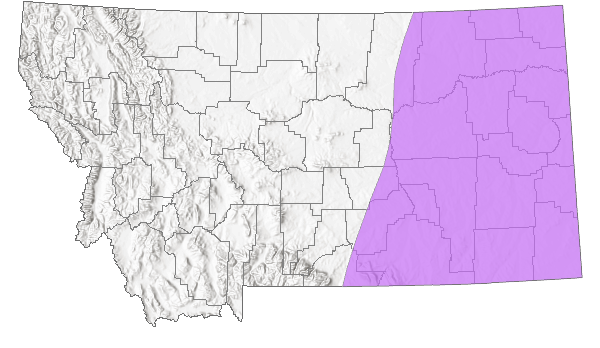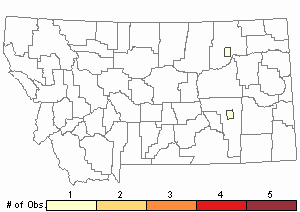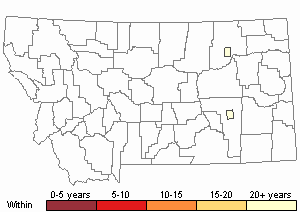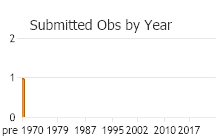View in other NatureServe Network Field Guides
NatureServe
Montana
Utah
Wyoming
Idaho
Wisconsin
British Columbia
South Carolina
Yukon
California
New York
Platte Range Grasshopper - Mestobregma plattei
General Description
The following is taken from Hebard (1928), Capinera and Sechrist (1982), Otte (1984), Vickery and Kevan (1985), McDaniel (1987), Capinera et al. (2004), Brust et al. (2008), and Scott (2010). This is a medium-sized, large-headed, small-eyed grasshopper. Its body color is a sandy tan to brown. The lateral lobe of the pronotum (thorax) is conspicuously marked with a dark, oblique stripe which fades at the top. The median ridge of the pronotum is elevated and cut by two sulci (grooves) forming high knobs anteriorly. A dark stripe, which can be faint or absent, on the head angles from the front of the eye to the front of the face below the antenna socket. The tegmina (forewings) is sometimes darker than the body, and bear two bands, fading dorsally, one at the base of the hind femur, the other at the middle. The disk of the hind wings can be pale yellow, orangish, or pinkish, with a dark, spurred band and transparent tip. The wings are long, extending beyond the abdominal tip. The inner face of the hind femur is black with a pale ring before the black knee. The hind tibia can be yellow-brown or blue.
Communicative behavior/Crepitation*
This species is not known to perform courtship flights, nor crepitate. Femur-tipping, femur-shaking, and ground-striking are performed during male aggression encounters. When courting a female, a male will employ femur-tipping and stridulation.* Flight is swift and low above the ground (Otte 1970, 1984, and Vickery and Kevan 1985).
*Crepitation is the sound produced by grasshoppers making a clicking or snapping noise with their wings when in flight, during courtship, territorial encounters or being disturbed.
*Stridulation is rubbing one body part against another, usually the hind femur against the forewing in the case of the Band-winged Grasshoppers. This is often used for attracting a female during courtship (Otte 1970).
Phenology
This species overwinters in the egg stage. Adults occur from July through September (Otte 1984, Vickery and Kevan 1985, Capinera et al. 2004, and Scott 2010).
Diagnostic Characteristics
The following comes from Hebard (1928), Capinera and Sechrist (1982), Otte (1984), Vickery and Kevan (1985), McDaniel (1987), Capinera et al. (2004), Brust et al. (2008), and Scott (2010). The body length to end of forewings is 22-32 mm for males, and 27-40 mm for females.
The Platte Range Grasshopper is fairly easy to recognize, but could be confused with Derotmema, Metator and certain Trimerotropis species (Capinera et al. 2004).
Species Range
Montana Range
Range Descriptions

 Native
Native
Range Comments
The Platte Range Grasshopper occurs from eastern Montana, western South Dakota, through eastern Wyoming, and Colorado, extending westward across southern Utah, all of Arizona, New Mexico, the western half of Texas, Oklahoma, most of Kansas and Nebraska, southward to extreme north Mexico. In Montana, this species has been reported in 4 eastern counties (Otte 1984, Vickery and Kevan 1985, Capinera et al. 2004, and Scott 2010).
Observations in Montana Natural Heritage Program Database
Number of Observations: 2
(Click on the following maps and charts to see full sized version)
Map Help and Descriptions
Relative Density

Recency


 (Observations spanning multiple months or years are excluded from time charts)
(Observations spanning multiple months or years are excluded from time charts)
Habitat
This species inhabits rocky areas and outcrops with sparse vegetation, scattered, stunted trees and shrubs (Otte 1984, Vickery and Kevan 1985, and Capinera et al. 2004).
Food Habits
The food habits of the Platte Range Grasshopper are poorly known but it has been observed feeding on shrubs and
Four-wing Saltbush (
Atriplex canescens) (Capinera and Sechrist 1982).
Reproductive Characteristics
Pair formation occurs by males approaching moving females on the ground and stridulate while approaching one to three times. The sound pulses are sometimes produced on both the upstroke and downstroke which result in two closely spaced pulses on each stroke, usually the sound is produced only on the downstroke. No further information relative to copulation, oviposition, nymphal instar development, etc. has been found in the literature. The Platte Range Grasshopper is a poorly understood species (Otte 1970, 1984, and Vickery and Kevan 1985).
Stewardship Responsibility
References
- Literature Cited AboveLegend:
 View Online Publication
View Online Publication Brust, M.L, W.W. Hoback, and R.J. Wright. 2008. The Grasshoppers of Nebraska. Lincoln, NB: University of Nebraska Extension Service, APHIS.
Brust, M.L, W.W. Hoback, and R.J. Wright. 2008. The Grasshoppers of Nebraska. Lincoln, NB: University of Nebraska Extension Service, APHIS. Capinera, J.L. and T.S. Sechrist. 1982. Grasshoppers of Colorado: Identification, Biology, and Management. Fort Collins, CO: Colorado State University Experiment Station, Bulletin 584S. 161 p.
Capinera, J.L. and T.S. Sechrist. 1982. Grasshoppers of Colorado: Identification, Biology, and Management. Fort Collins, CO: Colorado State University Experiment Station, Bulletin 584S. 161 p. Capinera, J.L., R.D. Scott, and T.J. Walker. 2004. Field Guide to Grasshoppers, Katydids, and Crickets of the United States. Ithaca, NY. Cornell University Press.
Capinera, J.L., R.D. Scott, and T.J. Walker. 2004. Field Guide to Grasshoppers, Katydids, and Crickets of the United States. Ithaca, NY. Cornell University Press. Hebard, M. 1928. The Orthoptera of Montana. Proceedings of the Academy of Natural Sciences of Philadelphia, Vol. 80:211-306.
Hebard, M. 1928. The Orthoptera of Montana. Proceedings of the Academy of Natural Sciences of Philadelphia, Vol. 80:211-306. McDaniel, B. 1987. Grasshoppers of South Dakota. Brookings, SD: South Dakota Agricultural Experiment Station, Bulletin TB 89.
McDaniel, B. 1987. Grasshoppers of South Dakota. Brookings, SD: South Dakota Agricultural Experiment Station, Bulletin TB 89. Otte, Daniel. 1970. A comparative study of communicative behavior in grasshoppers. Miscellaneous Publications, Museum of Zoology, No. 141. Ann Arbor, MI: University of Michigan.
Otte, Daniel. 1970. A comparative study of communicative behavior in grasshoppers. Miscellaneous Publications, Museum of Zoology, No. 141. Ann Arbor, MI: University of Michigan. Otte, Daniel. 1984. The North American Grasshoppers Volume II. Acrididae (Oedipodinae). Harvard University Press. 366 pp.
Otte, Daniel. 1984. The North American Grasshoppers Volume II. Acrididae (Oedipodinae). Harvard University Press. 366 pp. Scott, R.D. 2010. Montana Grasshoppers, Katydids, and Crickets A Pictorial Field Guide to the Orthoptera. MagpieMTGraphics, Billings, MT.
Scott, R.D. 2010. Montana Grasshoppers, Katydids, and Crickets A Pictorial Field Guide to the Orthoptera. MagpieMTGraphics, Billings, MT. Vickery, V. R. and D. K. M. Kevan. 1985. The grasshopper, crickets, and related insects of Canada and adjacent regions. Biosystematics Research Institute, Ottawa, Ontario. Publication Number 1777. 918 pp.
Vickery, V. R. and D. K. M. Kevan. 1985. The grasshopper, crickets, and related insects of Canada and adjacent regions. Biosystematics Research Institute, Ottawa, Ontario. Publication Number 1777. 918 pp.
- Additional ReferencesLegend:
 View Online Publication
View Online Publication
Do you know of a citation we're missing? Helfer, J.R. 1971. How to Know the Grasshoppers, Crickets, Cockroaches, and Their Allies. Revised edition (out of print), Mineola, NY: Dover Publications.
Helfer, J.R. 1971. How to Know the Grasshoppers, Crickets, Cockroaches, and Their Allies. Revised edition (out of print), Mineola, NY: Dover Publications.
- Web Search Engines for Articles on "Platte Range Grasshopper"
- Additional Sources of Information Related to "Insects"





